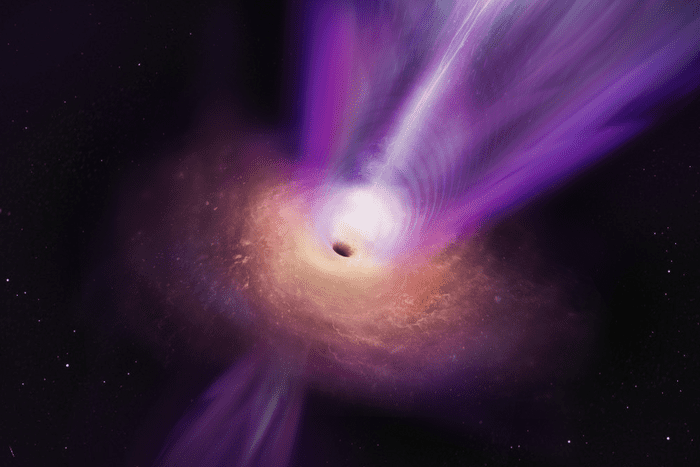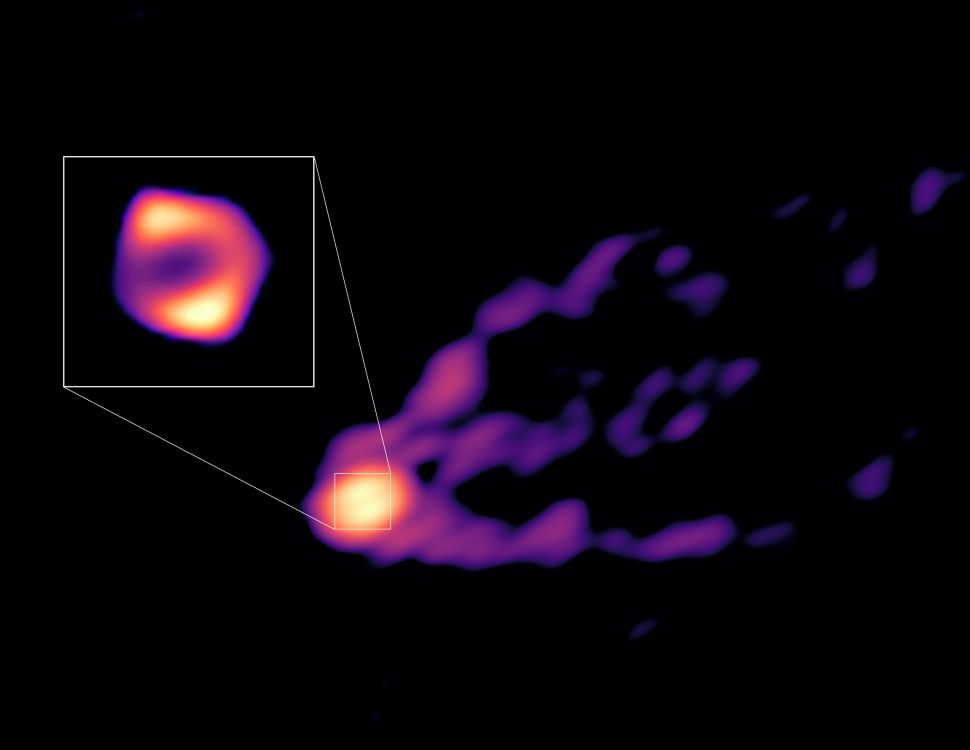
For the first time, scientists have produced an image revealing the ring-like structure of the accretion disk around a black hole and its associated powerful relativistic jet.
The black hole in question is Messier 87 (M87), a supermassive black hole 55 million light-years away which weighs in at approximately 6.5 billion times the mass of our Sun. Until now, astronomers have only been able to see M87 itself and the jet it produces in independent photos. Now, an international team of researchers has retrieved an image showing M87 and its jet both together in a panoramic picture at a wavelength of 3.5 mm.
“Previously we had seen both the black hole and the jet in separate images, but now we have taken a panoramic picture of the black hole together with its jet at a new wavelength,” says Ru-Sen Lu, from the Shanghai Astronomical Observatory and leader of a Max Planck Research Group at the Chinese Academy of Sciences.
Jets emitted from black holes can flow hundreds of thousands of light years and are still one of the cosmos’ many mysteries. Astronomers hope this new find can help answer some questions, like how they are created.
The image was created using the Global Millimeter VLBI Array (GMVA), a network of telescopes around the world that work together to produce high-resolution images of astronomical objects. This research made use of data obtained with the GMVA, which consists of telescopes operated by the Max-Planck-Institut für Radioastronomie (MPIfR), Institut de Radioastronomie Millimétrique (IRAM), Onsala Space Observatory (OSO), Metsähovi Radio Observatory (MRO), Yebes, the Korean VLBI Network (KVN), the Green Bank Telescope (GBT) and the Very Long Baseline Array (VLBA).
The combination of these observatories allowed the research team to image the ring-like structure around the black hole for the first time at this wavelength.

“With the greatly improved imaging capabilities by adding ALMA and GLT into GMVA observations, we have gained a new perspective,” said Thomas Krichbaum of MPIfR. “We do indeed see the triple-ridged jet that we knew about from earlier VLBI observations. But now we can see how the jet emerges from the emission ring around the central supermassive black hole and we can measure the ring diameter also at another (longer) wavelength.”
The diameter of the ring in the image is 50 percent larger than what was seen in previous observations by the Event Horizon Telescope at 1.3 mm. M87’s diameter measured by the GMVA is 64 microarcseconds. That is equivalent to the size of a small selfie ring light on Earth as seen by an astronaut on the Moon.
The new observations also reveal more details about the location and energy of the highly energetic electrons that produce the synchrotron radiation detected from M87. The team used computer simulations to test different scenarios and concluded that the larger extent of the ring is associated with the accretion flow.
Researchers also found something “surprising” in their data: the radiation from the inner region close to the black hole is broader than expected. This could mean more than just gas falling into the black hole. There could also be a wind blowing out, causing turbulence and chaos around it.
Despite this discovery, the quest to learn more about M87 is far from over. Future observations at millimeter wavelengths will study the time evolution of the black hole and provide a polychromatic view with multiple color images in radio light. With a fleet of powerful telescopes at their disposal, scientists will continue to unlock the secrets of the universe and reveal the mysteries of the cosmos.






